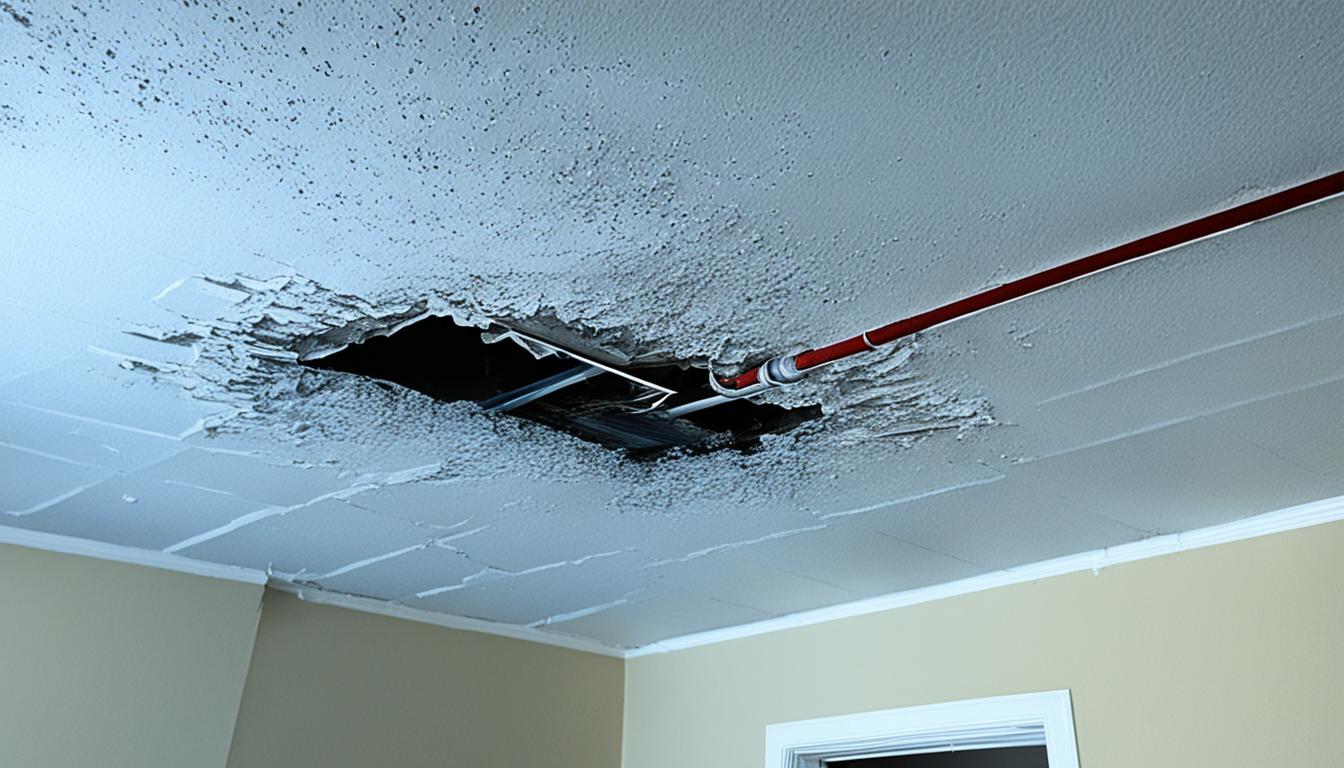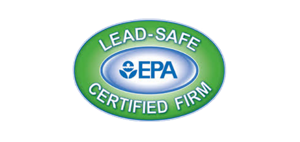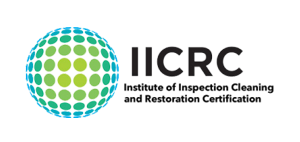Water damage can have severe consequences for your property, causing extensive structural damage, mold growth, and costly repairs. Understanding the common causes of water damage is crucial for protecting your investment and ensuring the safety and integrity of your home.
Whether you own a house, apartment, or commercial property, water damage can occur due to various factors. From plumbing leaks and weather-related issues to roofing problems and appliance failures, it’s essential to be aware of the potential risks and take proactive measures to prevent water damage from affecting your property.
In this article, we will explore the most common causes of water damage and provide valuable insights on how to protect your property from these issues. By implementing preventive measures, you can save yourself from the headache and financial burden of dealing with water-related damages.
Key Takeaways:
- Understanding the common causes of water damage is essential for protecting your property.
- Plumbing leaks and faulty systems can lead to significant water damage if not addressed promptly.
- Weather-related issues such as floods and heavy rainfalls pose a risk of water damage to homes.
- Roofing issues like damaged shingles and clogged gutters can result in water infiltration.
- Appliance failures, such as water heater or washing machine leaks, can cause unexpected water damage.
Plumbing Leaks: A Major Culprit of Water Damage
When it comes to water damage in homes, plumbing leaks are one of the primary culprits. Leaking pipes, burst pipes, and faulty plumbing systems can cause significant water-related issues if not addressed promptly. The consequences of plumbing leaks can range from minor water stains to severe structural damage, making it essential to tackle these issues as soon as they arise.
One of the most common plumbing issues that can lead to water damage is a leaky pipe. Over time, pipes can deteriorate or develop small cracks, resulting in slow leaks that may go unnoticed for a while. However, even a small leak can cause damage to surrounding walls, floors, and furniture if left unattended.
Burst pipes are another serious problem that can cause extensive water damage in a short amount of time. When pipes freeze, they can expand and crack, leading to sudden bursts and flooding. Burst pipes can cause significant damage to the structure of your home and require immediate attention to prevent further destruction.
Additionally, a faulty plumbing system can contribute to water damage from plumbing issues. Issues such as inadequate pipe insulation, incorrect pipe sizing, or poor installation can lead to leaks and other plumbing complications. Regular maintenance and inspections by a professional plumber can help identify and address potential problems before they cause significant water damage.
It is crucial to be proactive in detecting and addressing plumbing leaks to mitigate the risk of water damage. If you notice signs of water stains, dampness, or an unexplained increase in your water bill, it is essential to investigate and address the issue promptly. Ignoring plumbing leaks can result in costly repairs and extensive damage to your home.
In the next section, we will explore weather-related water damage, including floods and heavy rainfalls, as another common cause of water damage in homes.
Weather-Related Water Damage: Flooding and Heavy Rainfalls
When it comes to water damage, weather-related incidents can pose a significant threat to homes. Devastating floods, heavy rainfalls, and intense storms can wreak havoc on your property, leading to costly repairs and extensive damages. Protecting your home from these natural disasters is crucial in safeguarding your investment and ensuring the well-being of your family.
Floods are among the most common and destructive forms of weather-related water damage. Whether caused by heavy rains, melting snow, or overflowing bodies of water, floods can quickly inundate your home, resulting in structural damage, mold growth, and the loss of personal belongings. It is essential to have a comprehensive flood prevention plan in place, which may include measures such as installing flood barriers, sealing foundation cracks, and elevating essential appliances and utilities.
In addition to floods, heavy rainfalls can also lead to substantial water damage. Excessive rainfall can overwhelm drainage systems and cause water to seep into your home through cracks in the foundation, leaky roofs, or poorly sealed windows and doors. Regular inspections of your home’s exterior, maintenance of gutters and downspouts, and proper grading of your property can help mitigate the risk of water intrusion during heavy rainfalls.
Severe storms with high winds and heavy precipitation can exacerbate the potential for weather-related water damage. Strong winds can damage roofs, tear off shingles, and create openings for water to enter your home. Combined with heavy rain, these storms can lead to leaks, water infiltration, and subsequent structural deterioration. Regular roof inspections, prompt repairs, and ensuring proper sealing and caulking can help protect your home against storm damage.
| Steps to Protect Your Home from Weather-Related Water Damage |
|---|
| 1. Invest in flood insurance to mitigate financial risks associated with floods. |
| 2. Seal foundation cracks and apply waterproof coatings to prevent water seepage during floods. |
| 3. Install flood barriers or sandbags to divert floodwaters away from your home. |
| 4. Regularly inspect and maintain gutters and downspouts to ensure proper drainage during heavy rainfalls. |
| 5. Conduct routine roof inspections and promptly repair any damaged shingles or flashing. |
| 6. Enhance your home’s exterior sealing and caulking to prevent water intrusion during storms. |
Roofing Issues: A Hidden Cause of Water Damage
When it comes to protecting your home from water damage, it’s essential not to overlook roofing issues. Damaged shingles, clogged gutters, and faulty flashing can lead to water infiltration and roof leaks if not promptly addressed. These seemingly minor issues can result in extensive damage to your property and require costly repairs.
To understand the impact of roofing issues on water damage, it’s crucial to recognize how they contribute to water infiltration. Damaged shingles, whether due to age, severe weather, or other factors, create openings that allow water to seep into your home’s structure. This infiltration can lead to a range of problems, including ceiling stains, mold growth, structural weakening, and even electrical hazards.
Clogged gutters are another common roofing issue that can lead to water damage. When gutters become blocked by debris, such as leaves or twigs, they are unable to effectively direct water away from your home. As a result, water can overflow and accumulate near the foundation, increasing the risk of basement flooding and water seeping into your home’s interior.
Common Roofing Issues that Contribute to Water Damage:
- Missing or damaged shingles
- Clogged gutters
- Faulty flashing
- Improper roof ventilation
- Cracked chimney or skylight
- Poorly installed roofing materials
One frequently overlooked roofing issue that can cause water infiltration is faulty flashing. Flashing consists of metal strips or sheets installed around chimneys, skylights, and other roof penetrations to prevent water from seeping into the vulnerable areas. If the flashing is damaged or improperly installed, it can allow water to penetrate the roof, leading to leaks and water damage.
Regular roof inspections and maintenance are essential for identifying and addressing these roofing issues before they cause significant water damage. By scheduling professional inspections and promptly addressing any identified issues, you can protect your home from the devastating effects of roof leaks and water infiltration.
| Signs of Roofing Issues | Actions to Take |
|---|---|
| Missing or damaged shingles | Replace damaged shingles promptly |
| Clogged gutters | Clean gutters regularly and ensure proper drainage |
| Faulty flashing | Repair or replace flashing as needed |
| Cracked chimney or skylight | Seal cracks or consider professional repairs |
| Poorly installed roofing materials | Hire a professional to ensure proper installation |
Appliance Failures: Unexpected Sources of Water Damage
When it comes to water damage in your home, you may not immediately think of your appliances as culprits. However, appliance failures can lead to unexpected water damage if left unchecked. Understanding how these appliances can contribute to water damage and taking proactive measures can help you avoid costly repairs and protect your property.
One common appliance that can cause water damage is the water heater. Over time, water heaters may develop leaks due to corrosion or faulty valves. These leaks can go unnoticed for an extended period, leading to significant water damage in surrounding areas.
Another appliance to watch out for is the washing machine. Washing machines can develop leaks in their hoses or valves, resulting in water spillage onto your floors. If left unaddressed, these leaks can seep into your home’s foundation and cause structural damage.
Dishwashers are also frequent contributors to water damage. A malfunctioning dishwasher can lead to leaks, causing water to pool under it or flow into adjacent cabinets. This moisture can lead to mold growth and compromise the integrity of your kitchen’s infrastructure.
Lastly, refrigerators with water dispensers and ice makers can pose risks of water damage. Leaks in the water supply lines or faulty connections can lead to water spills or seepage into nearby areas, potentially causing damage to flooring, cabinets, or other structures.
To minimize the risk of appliance-related water damage, regular maintenance is crucial. Check your appliances for signs of wear and tear, such as rust, cracks, or loose connections. Consider scheduling professional inspections to identify any potential issues before they escalate.
Additionally, be vigilant about early signs of appliance failure, such as odd noises, slow drainage, or inconsistent performance. Promptly address these issues, either by repairing the appliances or seeking professional help.
By being proactive with appliance maintenance and repair, you can mitigate the risk of water damage in your home. Taking these precautionary measures will ensure the longevity of your appliances and the protection of your property.
Tips to Prevent Appliance-Related Water Damage:
- Regularly inspect your appliances for signs of wear and tear.
- Check water supply lines and connections for leaks or cracks.
- Address any strange noises or performance issues promptly.
- Have your appliances professionally inspected and serviced on a regular basis.
- Consider installing water leak detection devices to alert you of any leaks.
Conclusion
Water damage can be a costly and disruptive issue for homeowners, but by understanding the common causes and taking proactive measures, you can protect your property and minimize the risk. Plumbing leaks, weather-related events, roofing issues, and appliance failures are all potential culprits that can lead to water damage.
To safeguard your home, it’s important to regularly inspect your plumbing system for leaks, fix any issues promptly, and ensure proper maintenance. Additionally, preparing your home for severe weather conditions, such as installing flood barriers or reinforcing your roof, can help prevent water damage during storms and heavy rainfall.
Don’t overlook the importance of a well-maintained roof. Regular inspections and prompt repairs can prevent water infiltration and roof leaks. Lastly, keep an eye on your household appliances, as they can also contribute to water damage. Routinely check for any signs of leakage from your water heater, washing machine, dishwasher, or refrigerator, and address them immediately.
By taking these preventative steps, you can protect your investment and avoid the headache and expense of dealing with water damage. Remember, being proactive is key to keeping your property safe and secure. So stay vigilant, address any issues promptly, and enjoy the peace of mind that comes with a water-damage-free home!
FAQ
What are the common causes of water damage?
The common causes of water damage include plumbing leaks, weather-related issues such as floods and heavy rainfalls, roofing problems, and appliance failures.
How can I protect my property from water damage?
To protect your property from water damage, it is important to address plumbing leaks promptly, ensure proper drainage during severe weather conditions, regularly inspect and maintain your roof, and schedule routine maintenance for appliances prone to leaks.
How do plumbing leaks contribute to water damage?
Plumbing leaks, such as burst pipes or faulty plumbing systems, can lead to significant water damage if left unattended. They can cause flooding, damage to walls and floors, and potentially result in mold growth.
What should I do in case of a water-related emergency?
In case of a water-related emergency, it is crucial to act quickly. Shut off the main water supply, if possible, and contact a professional plumber or water damage restoration specialist to assess the situation and mitigate the damage.
How can weather-related water damage be prevented?
To prevent weather-related water damage, consider installing a sump pump and a backup generator, ensuring proper drainage around your property, and maintaining your gutters and downspouts. Additionally, you can consider waterproofing your basement or crawl space.
Are roof issues a common cause of water damage?
Yes, roofing issues can contribute to water damage if not addressed promptly. Damaged shingles, clogged gutters, and faulty flashing can all result in water infiltration and roof leaks.
How often should I inspect my appliances for potential leaks?
It is recommended to inspect your appliances, such as water heaters, washing machines, dishwashers, and refrigerators, at least once a year. Regular maintenance and early detection of potential leaks can help prevent water damage.









